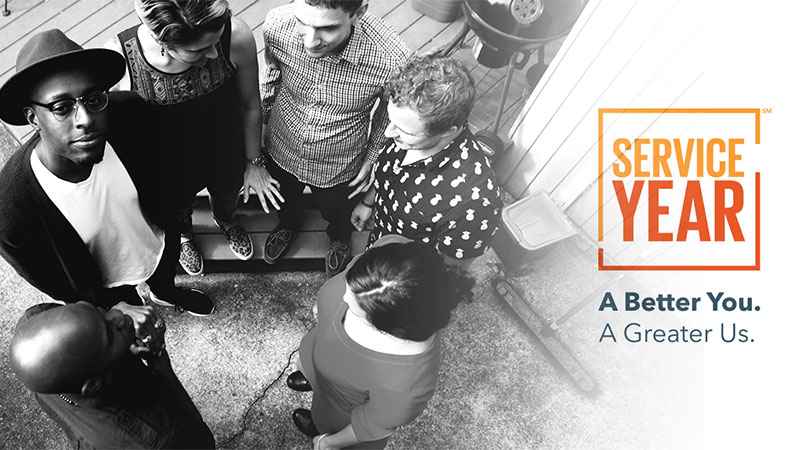Veterans of service year programs such as AmeriCorps, Peace Corps, YouthBuild, Teach for America, and VISTA go on to complete bachelor’s degrees at twice the rate of their peers and find jobs in occupations with annual salaries of as much as $80,000, new research shows.
With support from Lumina Foundation, the Service Year Alliance recently commissioned a study from Burning Glass Technologies that analyzed resumes of over 70,000 service year alumni and a comparison group of 100,000 otherwise similar resumes. The report studied:
- How often service year alumni completed a bachelor’s degree.
- What skills they cultivated.
- What careers they entered.
- Where they worked as their careers developed.
About 66,000 Americans enroll in one of these programs each year, and there are calls to grow that to more than 100,000 because of the strong anecdotal evidence of service year alums like Lashon Amado, whose service experience was his gateway to college.
“I am a first-generation college student, so I never saw college as an affordable or feasible option,” he said.
Amado’s mentors at Youthbuild Brockton, a town south of Boston saw potential and encouraged him to give the program a try.
“I figured I’d give college a shot,” he said. “I earned an A in my first class, and that empowered me to go further. Fast-forward five years and I now have my master’s from Northeastern University ─ my golden ticket to opportunity.”
Until recently, there’s been little evidence to support a major expansion in service year programs, but new data is in that we should pay attention to.
Alumni of these programs complete their bachelor’s degrees at twice the rate of their peers. Of those who earned degrees, three-fourths completed the full four-year degree program after finishing their service year, suggesting they had little to no college experience before the service year.
Shaquana Boykin, for example, recently graduated from CUNY—NYC College of Technology and credits her service year at Public Allies as the reason she finished college.
“At the time I had dropped out of college as a legal studies major, the prerequisite classes were not fulfilling me, and I wanted more than sitting in a college course checking off boxes to take classes for my major,” she said.
Boykin was struggling with bills as she worked a succession of odd jobs. Finally, she heard about Public Allies, which runs an AmeriCorps program and focuses on youth leadership development.
“The recruiter said: “They are accepting people who have ‘promise and potential to be a leader,’” Boykin recalled. Ten months later, in 2015, she re-applied to school.
“They took a chance, and I graduated in June 2018 with my B.S. in legal studies. I giggle thinking about my service year ─ now I am the Mayor’s Office Engagement Coordinator.”
Service year alumni are nearly four times more likely than their peers to work in education or community and social services occupations. After 10 years, 23 percent of alumni remain in education or community and social services; this is true of just 7 percent of their peers.
Chelsea Crinson is one of these alums. She received her degree from Southern New Hampshire University and works as human capital assistant at the Corporation for National & Community Service.
“I started my service year with AmeriCorps NCCC having a few college courses under my belt,” she says.
“After completing my service year, I realized I had found my passion, and giving back to others is what I love to do. This realization is what helped me to decide I wanted to go back to school for a career in service to others.”
Crinson earned her bachelor’s degree in human services last fall and said she “can’t thank my service year enough for this accomplishment.”
Service year alumni who lack a bachelor’s degree also earn more than their similarly educated peers, even though they’re disproportionately found in public-service fields that typically pay less. A greater proportion of service year alumni without a bachelor’s degree go on to work in occupations with average annual salaries of at least $80,000, compared to their similarly educated peers. This finding holds true five, seven, and 10 years after service.
The resumes of alumni are more likely than those of their peers to advertise skills such as research, planning, organizational skills, leadership, and mentoring. These are skills commonly developed in service year programs.
Marcus Williams did his year of service in City Year in Washington, D.C., in 2012-13. He later graduated from College of Mount Saint Vincent in New York City, where he majored in business and healthcare.
“When I applied for a service year, I had been accepted to multiple schools but wasn’t sure what I wanted out of life. I had been raised doing service and felt this was a great fit before college,” he said.
“While in college I became president of my class and also president of the student body for my junior and senior years. I have often credited most of my success as a student and leader to my year of service.”
Williams’ work with City Year, an AmeriCorps program that works with students in high-need communities, helped prepare him for college—and his career. The experience, he said, helped him get a job with the American Heart Association.
The Burning Glass findings make a compelling case for the importance of service years as a proven pathway to enable students to earn high-value, post-high school credentials and advance in careers in the nonprofit sector.
This research should fuel the recognition that service year programs are a critical talent pipeline for skills in high demand across many occupations and professions. The case is strong for expanding service year programs from the current 66,000 participants to more than 100,000. The expansion would provide assistance to resource-strapped nonprofit organizations and help many more Americans develop the skills needed for good careers in the nonprofit sector.
